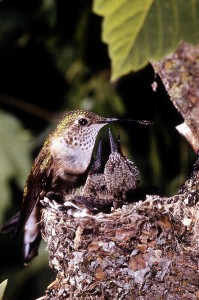If the task of choosing a hummingbird feeder seems a bit overwhelming, then this video will make the task much simpler. Roberta Beyer, owner of The Fat Finch, will help you discover why you want to select a feeder with lots of red on it, one that is easy to clean and fill, and one that does not leak or drip. You will also discover the advantages of both the bottle and saucer feeders as well as about a window feeder. Lastly, you will discover information about ant moats and weather guards for your hummingbird feeders.
Month: May 2010
Yes, Hummingbirds Do Have Feet
I am constantly amazed by the common falsehoods many people, both adults and children, still have about hummingbirds. Even in this age of technology and endless information, there are still people who mistakenly believe that hummingbirds do no have feet. How this can still be believed today is beyond me, because if you have ever seen a hummingbird it is obvious that the bird has feet. Just to be perfectly clear, hummingbirds do indeed have feet, and this post will provide some information about the hummingbird’s feet.
A hummingbird’s feet serve only one purpose, which is to enable the hummingbird to perch. Whenever a hummingbird must travel any distance, even just two inches, the bird must fly. Hummingbirds will lift off from a perch without pushing off and they rise solely through their own power. The hummingbirds obtain this power by flapping their wings at almost full speed before lifting off. Hummingbirds fly at a very high rate of speed and have the ability to stop suddenly and quickly and still make a soft landing. Hummingbirds are extremely light and therefore they do not build up much momentum.
The feet of the hummingbird are extremely weak and therefore the hummingbird is virtually unable to walk. The hummingbird uses its feet to unable it to perch.
As this post clearly examines, hummingbirds do indeed have feet. The hummingbird’s feet are extremely weak and perhaps poorly developed, but nevertheless the feet are still vitally important to the hummingbird because the feet enable the hummingbird to perch.

Have you ever wondered what can cause hummingbirds to fight each other? If so, then this post will offer you some insight as to why this occurs.
Hummingbirds will fight to protect their food source or to guard and defend their territory. The birds will use their bills and claws as weapons. Sometimes, the birds may even collide with one another.
It is quite rare for a hummingbird to be injured during a fight, because their instincts tell them not to risk injuring their bills. Amazingly enough, hummingbirds fight less whenever food is scarce. I was unable to find out a reason for this in any of the sources I read while researching this topic.
Hummingbirds do not attack humans, but they have been known to get within inches of someone’s face. This experience can indeed be frightening.
As I said before, a hummingbird will fight to defend its territory. Both the male and female each establish their own territory. The female’s territory is where the nest will be built and where the young will be feed. The male’s territory is a way for the male to protect a reliable food source. The male does not take any responsibility for the building of the nest or for the care and feeding of the young. If a female hummingbird enters a male hummingbird’s territory, he will perform aerial displays to keep her away. It is so important to both the sexes that individual territories be maintained that the act of mating takes place on neutral ground.
While it is impossible to try and explain every possible reason why hummingbirds fight, it is my sincere desire that this post will have provided some insight into this topic. Maybe you will understand better why there is often a fierce battle of the various hummingbirds at your feeders.
What is an Immature Hummingbird?
If you are someone who regularly observes hummingbirds, have you ever before thought about what the term immature means? until I was recently asked about this by someone, I myself had never before given the matter much consideration. After doing some research, here is what I can now share with you.
The term immature refers to a young bird which is independent but has yet to complete the molt into their adult plumage. You may now be wondering what is exactly meant by the term molt. Well, I have that answer for you as well. Molt is the normal cycle of loss and replacement of feathers.
I hope this post helps you understand what is meant by an immature bird. As I was writing this post, thoughts of my mom came to mind because I can imagine her wanting to know just how to determine if a bird is immature or not. If she were still alive today, I would be able to share this information with her as well.
One last thing, I do not normally like a post to require the use of so many definitions, but there was no other way to write this post without the use of these terms. Thanks for your understanding and please visit the site again.

Chances are you have never before seen a hummingbird nest, so I thought you might enjoy being able to see one through this photo.
The nest in this photo actually looks quite large to me, but looks can indeed be deceiving. A hummingbird nest is generally the size of a pea or half a walnut shell.
Most hummingbird nests are made of lichens, moss and fragments of bark, bound together with strands of spider web and lined with soft downy plant material like cottonwood fluff.
